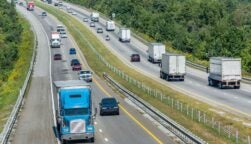65% of US freight professionals expect self-driving trucks to hit public roads by 2050, according to new insights from a recent survey by Tech.co.
Zoom in a little further, and you’ll see that some of them expect the revolutionary technology even sooner, with 42% of those survey respondents estimating that self-driving trucks will be traversing public roads as soon as 2040.
Other findings from the survey data include the fact that around a third of freight industry professionals say that self-driving trucks are good during low-traffic hours, while almost a fifth say that they would buy a self-driving truck over hiring a new driver, given the chance.
When Will Autonomous Trucks Become Widespread?
Tech.co’s survey tracked responses from 518 professionals within the US transport and shipping sector across May 2025. The biggest takeaway centers on the tech timeline that these workers predict for self-driving vehicles.
A full 65% of them foresee self-driving trucks on public roads across the nation by 2050, just 25 years from now. That statistic incorporates those who think the technology will be ready even sooner, too, with 42% saying it will be functional in 15 years.
 This just in! View
This just in! View
the top business tech deals for 2025 👨💻
Given that self-driving trucks hold an undeniable power to reshape entire industries, it’s no wonder that so many logistics professionals have an opinion.
Freight will likely be the first industry to embrace self-driving vehicles, since it offers the predictable schedules and routes that give autonomous technology clear boundaries and rules for operation. The financial incentive for adapting the technology also clear: Driver shortages are currently squeezing the trucking industry.
Do Logistics Professionals Actually Want Self-Driving Tech?
Once self-driving trucks arrive, will they actually be embraced by the industry? When a revolutionary technology comes along, from laptops to cell phones, it often takes literal decades to truely become ubiquitous.
Today’s professionals have a few caveats about the conditions that self-driving trucks will need to operate within in order to get a stamp of approval. Here’s what it takes to make self-driving trucks a good solution, according to our new May 2025 survey:
- Low traffic hours: 32% of logistics professionals say that self-driving tech works best when few vehicles are on the road.
- Long-haul highway journeys: 31% of respondents picked long-haul trips as the best scenario for self-driving trucks.
- Highway journeys between distribution centers: 29% of respondents picked this option, restricting trips to clear, pre-set destinations.
- Short haul journeys: 18% say self-driving tech is best for short haul trips, putting this option a little below those who prefer long-haul trips.
These scenario qualifications make sense. Self-driving technology would have fewer chances to make any mistakes when fewer road users are around, and the technology would likely be at its most buggy when it first debuts.
Plus, long-haul trips are the most attractive use for the technology from a cost perspective, since it would replace the hourly pay of a human driver with a flat fee for the vehicle itself. And if the technology is withheld for travel between distribution centers, humans can take back over for last-mile deliveries, which might be harder to automate.
Overall, the surveyed freight professionals are cautious about the nascent technology. Nearly a fifth (19%) of them say that they would pick a self-driving truck rather than recruit a new driver if they were given a choice — which leaves four-fifths who would not say the same.
The Driver Shortage Remains a Top Concern in 2025
Demand for freight is high despite the driver shortages: 87% of the surveyed professionals saying they have all the freight they can haul.
Could self-driving trucks arrive even sooner than 2045? That’s what Aurora Innovation is hoping: The company recently announced plans for fully autonomous trucks making trips across a 200-mile stretch of I-45 in Texas, although they are including a human observer in the driver’s seat for each trip.
Perhaps the big takeaway from our new survey is just how long a timeline many of today’s logistics pros are giving the new technology.
Driver shortages are definitely the biggest issue that trucking operations are dealing with in 2025. For the next 15 years, this new survey shows, many professionals don’t expect a lot to change.




